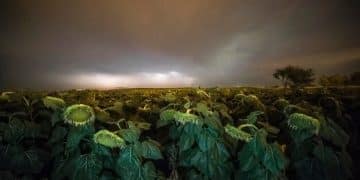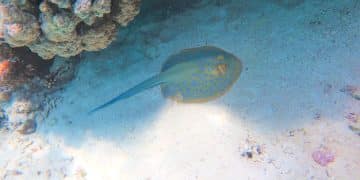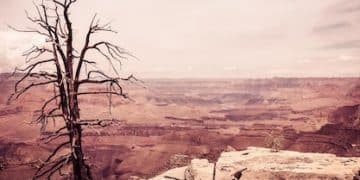Melting Permafrost: Methane Release & US Mitigation Strategies
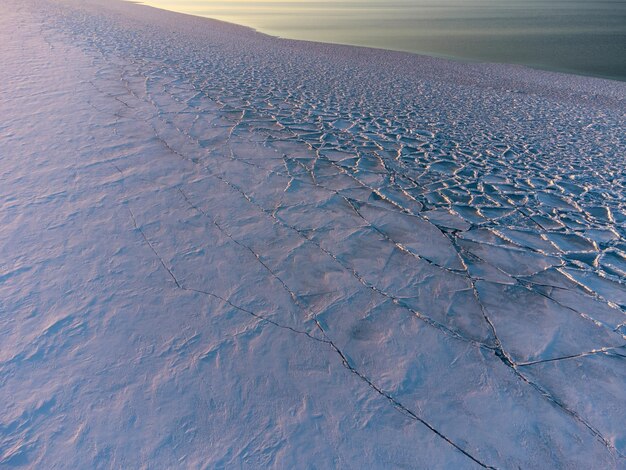
The melting permafrost in the Arctic and sub-Arctic regions poses a significant threat of methane release, impacting global climate patterns and demanding specific mitigation strategies, particularly for the US given its northern territories.
The thawing of permafrost, a consequence of our warming planet, is no longer a distant threat but an unfolding reality with profound implications for global climate. Understanding the potential for Melting Permafrost: How Much Methane Release Can the US Expect and What are the Mitigation Strategies? is crucial, especially for nations like the United States with significant Arctic and sub-Arctic territories.
The Permafrost Carbon Bomb: A Global Concern, A US Reality
Permafrost, ground that remains frozen for at least two consecutive years, stores an immense amount of organic carbon—nearly twice what is currently in the atmosphere. This carbon, locked away for millennia, becomes vulnerable when permafrost thaws. As temperatures rise, particularly in the Arctic, this ancient carbon can decompose, releasing potent greenhouse gases like carbon dioxide (CO2) and methane (CH4).
The release of these gases creates a dangerous feedback loop: warming temperatures thaw permafrost, which releases more greenhouse gases, leading to further warming. For the United States, with Alaska’s vast permafrost regions, this isn’t just an abstract scientific concept; it’s a direct environmental and economic threat. The infrastructure built on permafrost, from roads and buildings to pipelines, is already experiencing destabilization, leading to costly repairs and disruptions.
Understanding Methane’s Potency
While CO2 receives significant attention, methane is a far more potent greenhouse gas over shorter timescales. Although its atmospheric lifetime is shorter than CO2’s, methane has a global warming potential (GWP) approximately 28 to 34 times greater than CO2 over a 100-year period. This means that a relatively small release of methane can have a disproportionately large impact on atmospheric warming. The unique characteristics of methane make its potential release from thawing permafrost a particular concern.
- Higher warming potential: Methane is significantly more effective at trapping heat than CO2.
- Anaerobic decomposition: When organic material in thawed permafrost decomposes in oxygen-poor (anaerobic) conditions, it tends to produce methane.
- Positive feedback loop: Methane release accelerates warming, which in turn accelerates permafrost thaw, leading to more methane release.
Scientists are intensely studying the rates and volumes of methane release from various permafrost environments, including wetlands, lakes, and thermokarst features. These areas, characterized by uneven ground resulting from thaw, are often hotbeds for methane emissions as they create ideal conditions for anaerobic decomposition. The scale of this potential emission is what drives much of the global concern and research.
The implications for the U.S. extend beyond just environmental impact. Indigenous communities in Alaska rely heavily on traditional ways of life that are directly threatened by changes in permafrost. Hunting grounds, fishing areas, and travel routes are all being altered, impacting food security and cultural practices. Addressing this challenge requires a multi-faceted approach, balancing scientific understanding with practical adaptation and mitigation strategies.
Quantifying Methane Release: Projections for the US
Predicting the precise amount of methane release from permafrost is incredibly complex due to the multitude of variables involved. These include future warming trajectories, the depth and type of permafrost, microbial activity, and hydrological changes. However, scientific models and field observations provide a range of potential scenarios, highlighting the urgency of the situation for the US.
Current estimates suggest that Arctic permafrost contains about 1,300 to 1,600 gigatons of organic carbon. While not all of this will thaw or be released as methane, even a fraction could significantly impact global warming. For the US, particularly Alaska, the direct implications are substantial. Research indicates that Alaskan permafrost holds a significant portion of this global carbon store, and specific regions are already experiencing rapid thaw.
Modeling Future Emissions
Researchers use complex climate models to project future methane emissions from permafrost. These models incorporate various emission scenarios, from conservative to business-as-usual, to illustrate the range of possible outcomes. Uncertainty remains high, mainly because the biological and hydrological processes that govern methane production and release are not yet fully understood. However, the consensus is clear: significant releases are likely under continued warming.
- Scenario dependence: Emissions vary widely based on global temperature increases.
- Microbial activity: The specific types of microbes present dictate the balance between CO2 and methane production.
- Hydrological changes: Waterlogging often creates anaerobic conditions favoring methane, but drainage can shift to CO2.
Some studies project that by 2100, permafrost thaw could release an additional 50 to 200 gigatons of carbon, a substantial portion of which could be methane. While these numbers seem abstract, their cumulative effect on atmospheric methane concentrations would significantly amplify global warming efforts. The US contribution to this global total stems from Alaska’s vast and vulnerable permafrost landscapes, which are already experiencing some of the most rapid warming on the planet.

Understanding these projections is critical for policymakers and communities. It informs risk assessments for infrastructure, helps identify vulnerable ecosystems, and guides the development of adaptive strategies. While the exact numbers remain elusive, the trend is undeniable, and the need for proactive measures becomes increasingly apparent as more data emerges. The scientific community continues to refine these models, providing increasingly accurate insights into what the future might hold.
Impacts on US Infrastructure and Ecosystems
The thawing of permafrost has direct and severe impacts on the United States, extending beyond atmospheric changes to tangible effects on infrastructure, ecosystems, and human communities, particularly in Alaska. Roads, buildings, airports, and pipelines built on what was once stable, frozen ground are now experiencing subsidence and collapse, leading to significant economic burdens and safety risks.
Alaskan communities, many of which are rural and Indigenous, are disproportionately affected. Housing, sanitation systems, and traditional hunting and fishing grounds are all at risk. The structural integrity of critical infrastructure like the Trans-Alaska Pipeline System, which transports oil across thousands of miles of permafrost, is under constant scrutiny and requires expensive maintenance to prevent potentially catastrophic failures.
Ecological Shifts and Land Instability
Beyond infrastructure, ecosystems are profoundly altered. Thawing permafrost creates thermokarst landscapes, characterized by uneven ground, sinkholes, and new lakes, dramatically reshaping the environment. This alters drainage patterns, impacts plant growth, and affects wildlife habitats. Many species are critically dependent on the stability of permafrost, and its disappearance can trigger cascading ecological effects.
- Road and building damage: Subsidence causes structural failures, requiring costly repairs.
- Ecosystem disruption: Shifting landscapes impact plant life, animal migrations, and water quality.
- Coastal erosion: Thawing permafrost along coastlines contributes to accelerated erosion, threatening communities.
Coastal erosion, exacerbated by thawing permafrost and diminishing sea ice, is particularly severe in many Alaskan villages. Entire communities are facing relocation due to rapidly eroding coastlines, a humanitarian crisis driven by climate change. The loss of stable ground also affects traditional subsistence activities, as it changes access to resources and alters the patterns of hunting and fishing. These changes directly threaten the unique cultural heritage and food security of Native Alaskan populations.
The economic costs associated with repairing and adapting infrastructure in permafrost regions are projected to be in the billions of dollars, imposing a significant strain on local and federal budgets. This multifaceted impact underscores the need for comprehensive planning and multi-sectoral collaboration to address both the immediate challenges and the long-term consequences of permafrost thaw across the US Arctic.
Mitigation Strategies: Reducing Methane in the Atmosphere
Addressing the complex challenge of methane release from thawing permafrost requires a two-pronged approach: global emission reductions to slow warming and specific strategies to manage permafrost thaw and its emissions. While directly preventing permafrost thaw on a large scale is formidable, concerted efforts can mitigate the overall impact. International cooperation and national policy are critical.
The primary mitigation strategy is, of course, to reduce global greenhouse gas emissions to limit overall warming. This involves transitioning to renewable energy, improving energy efficiency, and implementing carbon capture technologies. Slower warming translates directly to slower permafrost thaw and, consequently, less methane and CO2 release. This is the overarching solution that underpins all other efforts.
Targeted Approaches and Research
Beyond broad emission cuts, specific strategies are being explored to directly address methane emissions from permafrost. These include:
- Reforestation and revegetation: Planting trees and restoring vegetation can stabilize permafrost by shading the ground and maintaining cooler temperatures. It also helps sequester carbon.
- Active permafrost management: In some localized areas, techniques like snow management (e.g., packing snow to create insulation) or installing thermosiphons can help keep the ground frozen.
- Arctic Carbon Cycle Research: Investing in scientific research to better understand exact mechanisms of methane release and feedback loops can lead to more precise mitigation strategies. This includes monitoring programs to track changes in permafrost temperatures and emissions.
Another crucial area is methane leak detection and repair from human activities, such as oil and gas operations. While not directly related to permafrost thaw, reducing anthropogenic methane emissions complements efforts to manage the natural release. Any reduction in atmospheric methane, regardless of its source, contributes to slowing global warming and thus helps preserve permafrost. These strategies require significant investment and coordinated action across multiple sectors.
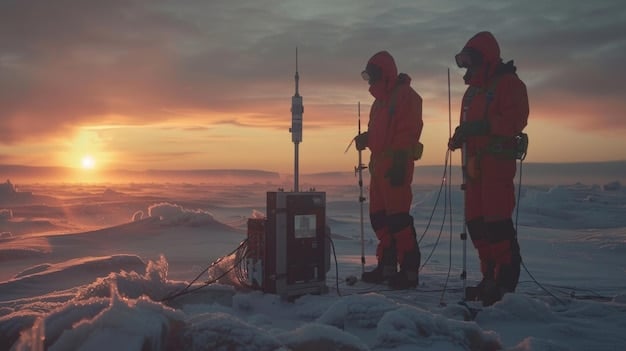
For the US, this involves bolstering climate policy, increasing investment in renewable energy, and supporting international agreements aimed at reducing global emissions. It also means continued support for scientific research into permafrost dynamics and methane cycling, as this scientific understanding forms the foundation for effective mitigation efforts. The scale of the challenge necessitates a blend of global and local actions.
Adaptation Strategies: Living with Thawing Permafrost in the US
recognizing that some permafrost thaw is inevitable, adaptation strategies are crucial for communities and infrastructure in the US Arctic. These strategies focus on minimizing the negative impacts of thaw and building resilience. They involve a combination of engineering solutions, land-use planning, and community engagement to ensure safety and sustainability in changing environments.
One key adaptation strategy is a more robust and flexible approach to infrastructure development. This means moving away from traditional building methods that assume stable ground and instead designing structures that can accommodate ground shifts, or identifying sites with less vulnerable permafrost. Elevating buildings on stilts or using thermosyphons to keep foundations frozen are examples of such engineering solutions. These methods increase construction costs but offer long-term stability.
Community Resilience and Planning
For human communities, especially Indigenous populations, adaptation involves supporting traditional knowledge and developing community-led planning. This includes:
- Relocation planning: For villages facing severe coastal erosion, exploring managed retreat and relocation options becomes a critical, albeit difficult, necessity.
- Food security diversification: Adapting to changes in traditional hunting and fishing grounds by exploring alternative food sources or methods.
- Early warning systems: Developing systems to monitor permafrost stability and provide warnings for potential infrastructure failures or environmental hazards.
Land-use planning must also evolve. Detailed mapping of permafrost conditions helps guide where development can safely occur and where it should be restricted. This often involves collaborating with local and Indigenous communities whose centuries of living on the land provide invaluable insights into permafrost dynamics and environmental changes. The goal is to minimize risk and ensure the continuity of life and culture in challenging circumstances.
The financial implications of adaptation are significant, requiring substantial investment from federal, state, and local governments. However, the cost of inaction, in terms of infrastructure damage, forced displacement, and loss of cultural heritage, would be far greater. Effective adaptation is about proactive planning and flexible responses to a dynamic and evolving environment. It’s about learning to live with the changes while still striving to mitigate their root causes.
Policy and International Cooperation: A Path Forward
Addressing the challenges posed by melting permafrost and methane release necessitates strong policy frameworks and robust international cooperation. No single nation, including the US, can tackle this issue in isolation. Global warming is a shared problem, and its regional manifestations, like permafrost thaw, require coordinated global solutions and sustained commitment. Domestically, coherent policy is essential to guide research, mitigation, and adaptation efforts.
Internationally, the United States plays a crucial role in various forums, including the Arctic Council, which focuses on issues affecting the Arctic region. Collaborative research initiatives, data sharing, and joint funding for permafrost monitoring projects are vital. Diplomacy can also drive global agreements on methane emissions reduction from all sources, recognizing the outsized impact methane has on near-term warming. Promoting best practices for Arctic development and environmental stewardship is also part of this international dialogue.
Domestic Policy Imperatives for the US
Within the US, several policy imperatives stand out. First, continued and increased funding for permafrost research and monitoring is essential for reducing uncertainties and improving predictive models. This scientific foundation informs all other policy decisions. Second, developing and enforcing building codes and infrastructure standards specifically adapted for thawing permafrost conditions is non-negotiable for future development in Alaska and other vulnerable regions.
- Increased research funding: Essential for better understanding and prediction.
- Adapted building codes: Ensures resilient infrastructure in permafrost zones.
- Support for Arctic communities: Financial and technical assistance for adaptation and relocation.
Third, providing financial and technical support to Arctic communities facing the direct impacts of permafrost thaw and coastal erosion is a moral and practical imperative. This includes funding for community relocation, adaptation infrastructure, and support for traditional subsistence economies. Fourth, the US must continue to lead by example on climate action, aggressively reducing its own greenhouse gas emissions in line with scientific recommendations and international commitments.
Effective policy also integrates Indigenous knowledge, recognizing the deep understanding that local communities have of their environment and the changes occurring within it. Their insights are invaluable for developing adaptation strategies that are culturally appropriate and practically effective. Ultimately, a comprehensive approach blending science, engineering, community wisdom, and political will is necessary to navigate the complex future shaped by melting permafrost.
| Key Point | Brief Description |
|---|---|
| 🧊 Permafrost Thaw | Vast carbon stores in frozen ground destabilize, releasing potent greenhouse gases. |
| 💨 Methane Release | Anaerobic decomposition of thawed organic matter produces highly potent methane. |
| 🏛️ US Impacts | Threatens Alaskan infrastructure, ecosystems, and Indigenous communities. |
| 🛠️ Strategies | Requires global emission cuts, specific permafrost management, and adaptation measures. |
Frequently Asked Questions About Melting Permafrost
▼
While carbon dioxide contributes more to long-term warming, methane is a far more potent greenhouse gas over shorter timescales, roughly 28-34 times more effective at trapping heat over 100 years. Its rapid, intense warming potential makes its release from thawing permafrost a significant immediate concern, accelerating the positive feedback loop of warming.
▼
The US, particularly Alaska, faces infrastructure damage (roads, buildings, pipelines collapsing), altered ecosystems (thermokarst formation, changes to wildlife habitats), and coastal erosion. Indigenous communities are disproportionately affected, facing threats to homes, critical services, and traditional subsistence practices, leading to significant economic and social challenges.
▼
Yes, in certain contexts, planting trees and revegetating can help. Tree cover and vegetation provide shade, which helps maintain cooler ground temperatures and can stabilize permafrost. This also sequesters carbon from the atmosphere. While not a standalone solution, it’s a valuable component of a broader mitigation strategy for specific areas.
▼
Thermosiphons are passive heat exchange devices used in permafrost engineering. They are designed to draw heat out of the ground during colder months, effectively transferring it into the atmosphere. This process keeps the ground frozen and stable even as ambient air temperatures rise, helping to preserve the integrity of foundations and infrastructure.
▼
Melting permafrost is a global climate issue. International cooperation through forums like the Arctic Council facilitates shared research, data collection, and policy development among Arctic nations. Global agreements to reduce overall methane and greenhouse gas emissions are also crucial, as slowing global warming directly lessens the rate of permafrost thaw in the US and worldwide.
Conclusion
The melting of permafrost and the subsequent release of methane present a formidable challenge, particularly for the United States with its significant Arctic territories. The projected methane emissions, while uncertain in precise volume, underscore an urgent need for action. Addressing this requires a dual approach: aggressive global mitigation through substantial greenhouse gas reductions to slow the rate of warming and targeted adaptation strategies for communities and infrastructure already experiencing thaw. It is a testament to the interconnectedness of our planet’s systems and a call for concerted, cross-disciplinary efforts to protect vulnerable environments and the populations that rely on them.


